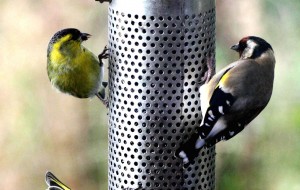 Readers have been emailing me about the sudden marked decrease in garden birds coming to an assortment of feeders. The main birds are siskins, lesser redpolls and greenfinches. Apart from the obvious decrease in the number of birds the change has also been noticed in a variety of ways. For one thing the feeders filled with nyjer seed suddenly have not needed daily refilling as they have done for the rest of the year. Nyjer is a comparatively recent addition to the now very wide range of feed put out every day all the year round by people. It is a very fine black coloured seed that is often referred to, wrongly, as thistle seed because it is so tiny. It is in fact the seed from a yellow daisy and so beloved by certain birds that If it is available they will go for nothing else. This fine seed is believed to be the reason for the increase in garden feeding siskins and lesser redpolls in recent years.
Readers have been emailing me about the sudden marked decrease in garden birds coming to an assortment of feeders. The main birds are siskins, lesser redpolls and greenfinches. Apart from the obvious decrease in the number of birds the change has also been noticed in a variety of ways. For one thing the feeders filled with nyjer seed suddenly have not needed daily refilling as they have done for the rest of the year. Nyjer is a comparatively recent addition to the now very wide range of feed put out every day all the year round by people. It is a very fine black coloured seed that is often referred to, wrongly, as thistle seed because it is so tiny. It is in fact the seed from a yellow daisy and so beloved by certain birds that If it is available they will go for nothing else. This fine seed is believed to be the reason for the increase in garden feeding siskins and lesser redpolls in recent years.
The decrease in many garden birds has also meant a marked decrease in the amount of garden food being sold by suppliers. For example, the one I deal with is in Dores and when they delivered the latest order this morning they said they have noted a recent decline in orders for garden feed. The only exception is the sunflower hearts but that is only because the chaffinches go for this and their numbers have certainly not decreased. However, as far as chaffinches are concerned there have been subtle change taking place in gardens. One reader, on the Black Isle, emailed me to report a sudden increase in chaffinches but they seemed different to the resident birds. For one thing they were very flighty and easily disturbed and there seemed to be a predominance of males. These are almost certainly immigrant chaffinches coming in from Scandinavia which is normal for this time of the year. What is fascinating with these immigrants is that, for some unknown reason, the females travel further than the males. This can end up with the flocks reaching Ireland being mainly females whilst those in the Highland’s being mainly males.
So where have the siskins and lesser redpolls gone, and for that matter the greenfinches? The answer lies in the abundance, or otherwise, of the natural food in the surrounding countryside. Siskins and lesser redpolls feed mainly on the small seeds of such trees as birch, larch, alder and the seed from cones of various pines. There was a shortage of these natural seeds earlier in the year which resulted in unusually large numbers of birds, in particular siskins, coming in to garden feeders. This garden feeding was so successful that there were reports of not only two broods but even, in one or two areas, of three broods. The photograph shows a goldfinch and a male siskin at a nyjer feeder. Then a few weeks ago the situation changed and the “wild” food source suddenly came to the fore, hence so many birds leaving the garden feeders.
The absence of the blackbirds is also for the same reason although they feed mainly on fruit and berries in the autumn and early winter. Many of the residents will return to gardens but some move to Ireland for the winter. Ringing shows that about 12 % of the wintering blackbirds are immigrants from Europe. They cannot be identified until March when the resident blackbirds will have their orange-yellow beaks and eye rings. Those from Europe will not change like this until they return to their breeding grounds so the you can tell the difference. The yellow colour was aptly summed up by Thomas Hardy who called it “crocus coloured”.
